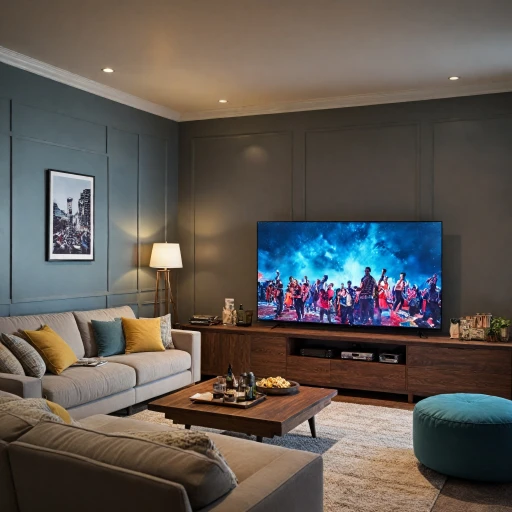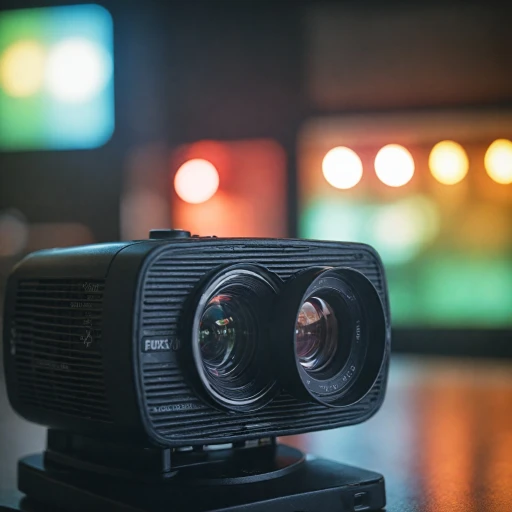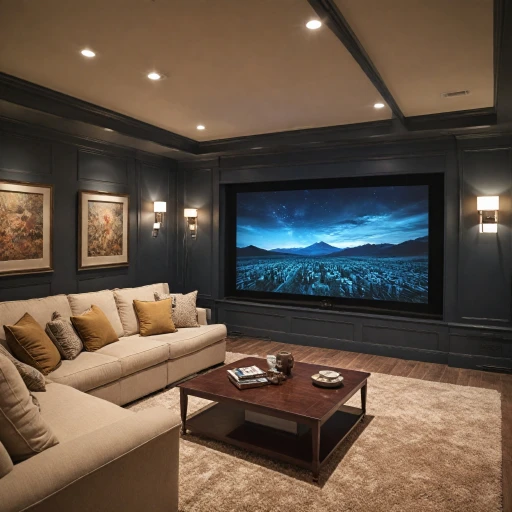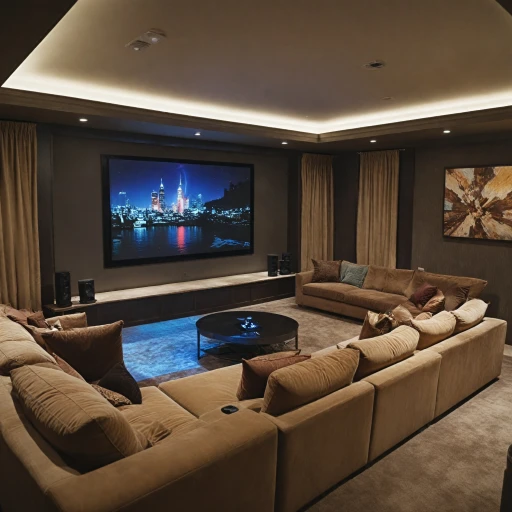What is a Short Throw Projector?
Exploring the Advantages of Short Throw Projectors
For those creating a captivating home theater experience, understanding what a short throw projector offers is crucial. These projectors are particularly designed to project a large image from a short distance, making them ideally suited for smaller rooms or spaces where flexibility is limited. Short throw projectors typically have a throw ratio of less than 1, which means they can project a sizable image even when positioned close to the screen. But why might one choose a short throw over other types? Let's delve into some of the unique benefits:- Versatility in Placement: If your setup options are limited by space, short throw projectors provide a practical solution by allowing you to install them just inches from the screen, preserving valuable room space.
- Reduced Shadows and Glare: Because short throw projectors minimize the distance between the projector and screen, users experience fewer shadows from objects or people that might pass in front of the image path.
- Enhanced Image Quality in Small Spaces: Despite the shorter distance, these projectors deliver vibrant and clear images, even in rooms with ambient light challenges. However, coupling with an ALR screen can better combat these light obstacles, resulting in superior image clarity.
- Simplified Installation: Without the need for long cables or complex installations often required for standard throw projectors, setting up a short throw projector can be straightforward, making it a great option for users prioritizing ease of use.
Understanding Long Throw Projectors
The Long Reach of Projection Technology
Long throw projectors are prized for their ability to produce large images when placed at extended distances from the screen, making them an excellent choice for expansive spaces. Unlike ultra short throw projectors (UST projectors), these standard throw projectors require a larger throw distance, sometimes spanning tens of feet, depending on the desired screen size. In a room with ample space, a long throw projector can provide cinematic experiences that are hard to beat. The throw ratio, which is the relationship between the distance from the screen and the width of the image, is crucial in determining how far away the projector needs to be to achieve a specific image size. This characteristic is especially useful when installing projectors in large home theaters where seating arrangements and room size allow for greater flexibility. Moreover, these projectors often come with lenses designed to focus light efficiently across a broader throw distance, ensuring consistent brightness and sharpness. However, it's important to consider the impact of ambient light. Because a long throw projector typically projects from farther away, it may be more susceptible to light interference. Thus, investing in an ambient light rejecting (ALR) screen can significantly enhance image quality. When considering a long throw projector, brands like the XGIMI Horizon Pro or a capable laser projector might be your best bet. They offer excellent image quality and adaptability, often making them a better fit for larger rooms compared to their short throw counterparts. As you compare these options, think about your room's setup and light conditions to decide which might suit your home theater best.Comparing Image Quality: Short Throw vs Long Throw
Assessing Visual Performance: Short Throw vs Long Throw Image Quality
Examining the image quality between short throw and long throw projectors offers insight into which device might suit your home theater best. The choice can impact your overall cinematic experience, influenced by factors such as light, distance, and screen options. Brightness and Ambient Light Short throw projectors, often with an ultra short throw (UST) design, excel in brighter environments. This is due to their ability to project from a closer proximity, which tends to offer higher light concentration on the screen. Subsequently, short throw projectors are often paired with ambient light rejecting (ALR) screens to combat additional lighting sources, maintaining vibrant and clear images even in well-lit rooms. Conversely, long throw projectors, when placed at adequate distances, produce stunning image quality ideal for dark, cinema-like settings. Their capacity to fill large screens with richly detailed visuals makes them a classic choice for dedicated theater rooms where light control is easier. Resolution and Detail Both types of projectors can support high-definition content, frequently offering 4K resolution. Advanced models, like laser projectors, ensure crisp and finely detailed projections regardless of throw distance. As short throw projectors are closer to the screen, they might offer slightly sharper images due to reduced pixel diffusion over space. Color Accuracy The color performance of projectors depends heavily on the technology employed, such as DLP, LCD, or LED, rather than strictly on the throw ratio itself. However, given the potential for ambient light interference in shorter throw distances, superior color accuracy can sometimes be more consistently achieved with long throw projectors in controlled light environments. Screen Size and Flexibility Long throw projectors typically offer greater flexibility in screen size and room placement. Their adjustable throw distance allows customization to large screen formats effectively, which is beneficial for larger rooms and immersive cinematic experiences. Short throw projectors, like the Xgimi models and horizon pro, are often preferable for smaller rooms or areas where space is a constraint. They provide large screen images from a minimal distance, a significant advantage for confined spaces. For further insights into the significance of light and projection in home theaters, consider visiting a dedicated resource on understanding projection lighting for home theaters. It offers additional context on how light settings interact with throw types to influence viewing quality.Space and Setup Considerations
Space Optimization and Installation Considerations
When setting up a home theater, the layout and size of your room play a crucial role in determining which type of projector will best suit your needs. The choice between a short throw and a long throw projector is largely influenced by how you intend to use the available space. Short throw projectors have a distinct advantage in smaller rooms. With a short throw ratio, these projectors can produce a large image from a closer distance to the screen, making them ideal for compact spaces. If you're working with limited room size, a short throw or even an ultra short throw (UST) projector might be the best fit. Utilizing UST projectors can allow you to place the unit very close to the screen, saving valuable room real estate. On the other hand, long throw projectors can be more beneficial in larger spaces where they can be positioned at the back of the room. This setup creates flexibility in seating arrangements and room design, ensuring that the projector does not obstruct the view or disrupt the interior aesthetics. Long throw distances enable the projector to be hidden away, maintaining a clean look while still delivering an immersive viewing experience. In either scenario, pairing the throw projector with an appropriate screen is crucial. ALR (Ambient Light Rejecting) screens are an excellent choice to enhance image quality, especially in spaces with moderate ambient light. While short throw projectors often work best with ALR screens to combat light interference, a standard throw setup might benefit from larger screens due to their capacity to project over greater distances. Ultimately, consider factors like throw ratio, room dimensions, and potential light conditions when evaluating projector placement and screen options. Each type of projector offers unique advantages tailored to specific space configurations, ensuring the best image quality for your home theater.Cost Implications and Budgeting
Financial Aspects of Choosing Your Projector
When it comes to budgeting for a home theater projector, understanding the cost implications of short throw and long throw projectors is crucial. Both types of projectors come with their own set of financial considerations, and your choice will depend on several factors, including your room size and desired image quality.
Short throw projectors, like the ultra short throw (UST) models, often have a higher initial cost. This is because they incorporate advanced technology to project large images from a short distance, making them ideal for smaller rooms. The XGIMI Horizon Pro, for instance, is a popular choice due to its ability to deliver impressive image quality even in limited spaces. However, the investment might be higher upfront compared to standard throw projectors.
On the other hand, long throw projectors generally offer more affordable options. These projectors are designed for larger rooms where the projector can be placed further away from the screen. While the initial cost might be lower, you may need to consider additional expenses such as ceiling mounts or longer cables, which can add to the overall setup cost.
Another factor to consider is the type of screen you will use. ALR (Ambient Light Rejecting) screens can enhance the image quality of both short and long throw projectors, but they also come with a higher price tag. The choice of screen can significantly impact the total cost of your home theater setup.
When planning your budget, also consider the long-term costs associated with projector maintenance. Laser projectors, for example, tend to have a longer lifespan and require less maintenance compared to lamp-based projectors, which can be a cost-saving factor over time.
Ultimately, the best choice for your home theater will depend on balancing your budget with your specific needs and room conditions. Whether you opt for a short throw or long throw projector, understanding these cost implications will help you make a more informed decision.
Making the Right Choice for Your Home Theater
Deciding the Best Projector for Your Home Theater
Choosing the right projector for your home theater involves considering several factors that influence your viewing experience, and deciding between a short throw and long throw projector is a crucial part of the process.
Firstly, examine your room size and arrangement. If your room is small or has limited space, a short throw projector with its minimal throw distance might be the ideal choice. On the other hand, a long throw projector might be better for larger rooms where a greater distance can be utilized.
Moreover, think about the lighting conditions in your room. An ultra short throw projector often provides a brighter image that effectively combats ambient light, making it suitable for rooms without controlled lighting. In contrast, long throw projectors usually need controlled light settings or an ALR screen to ensure the best image quality.
Consider the type of content you prefer. For those who aim to create an immersive experience with a large screen, the choice of projector is crucial. Short throw projectors are typically better for creating vibrant images on bigger screens at close distances, while long throw projectors may excel in delivering detailed, high-quality images from a distance.
Lastly, budget plays a significant role in your decision. Evaluate the cost implications of each projector type, including any additional requirements like a UST projector screen for optimal performance. The right balance between performance and budget will lead you to the most suitable projector.
In summary, the best choice depends on your specific needs and room environment. Carefully weigh the throw distance, image quality, available space, and budget to make an informed decision. Investing time in understanding these elements will ensure your home theater setup delivers an exceptional viewing experience.




